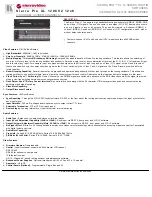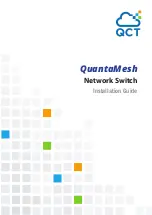
156
Identification Discovery of endpoints is a critically important aspect of VoIP systems in
general.In addition, it is best to advertise only those pieces of information which are
specifically relevant to particular endpoint types (for example only advertise the voice
network policy to permitted voice-capable devices), both in order to conserve the limited
LLDPU space and to reduce security and system integrity issues that can come with
inappropriate knowledge of the network policy.
With this in mind LLDP-MED defines an LLDP-MED Fast Start interaction between the
protocol and the application layers on top of the protocol, in order to achieve these related
properties. Initially, a Network Connectivity Device will only transmit LLDP TLVs in an
LLDPDU. Only after an LLDP-MED Endpoint Device is detected, will an LLDP-MED capable
Network Connectivity Device start to advertise LLDP-MED TLVs in outgoing LLDPDUs on the
associated port. The LLDP-MED application will temporarily speed up the transmission of the
LLDPDU to start within a second, when a new LLDP-MED neighbor has been detected in
order share LLDP-MED information as fast as possible to new neighbors.
Because there is a risk that a LLDP frame being lost during transmission between neighbors,
it is recommended to repeat the fast start transmission multiple times to increase the
possibility for that the neighbors has received the LLDP frame. With Fast start repeat count it
is possible to specify the number of times the fast start transmission is repeated. The
recommended value is 4 times, giving that 4 LLDP frames with a 1 second interval will be
transmitted, when a LLDP frame with new information is received.
It should be noted that LLDP-MED and the LLDP-MED Fast Start mechanism is only
intended to run on links between LLDP-MED Network Connectivity Devices and Endpoint
Devices, and as such does not apply to links between LAN infrastructure elements, including
between Network Connectivity Devices, or to other types of links.
Coordinates Location
◆
Latitude
– Normalized to within 0-90 degrees with a maximum of 4 digits. It is possible to
specify the direction to either North of the equator or South of the equator.
◆
Longitude
– Normalized to within 0-180 degrees with a maximum of 4 digits. It is possible
to specify the direction to either East of the prime meridian or West of the prime meridian.
◆
Altitude
– Normalized to within -32767 to 32767 with a maximum of 4 digits. It is possible
to select between two altitude types (floors or meters).
■ Meters: Representing meters of Altitude defined by the vertical datum specified.
■ Floors: Representing altitude in a form more relevant in buildings which have different
floor-to-floor dimensions. An altitude = 0.0 is meaningful even outside a building, and
represents ground level at the given latitude and longitude. Inside a building, 0.0
represents the floor level associated with ground level at the main entrance.
◆
Map Datum
– The Map Datum used for the coordinates given in this Option.
■ WGS84: (Geographical 3D) - World Geodesic System 1984, CRS Code 4327, Prime
Meridian Name: Greenwich.
Summary of Contents for GEP-1070
Page 80: ...80 authentication from any point within the network...
Page 168: ...168...
















































